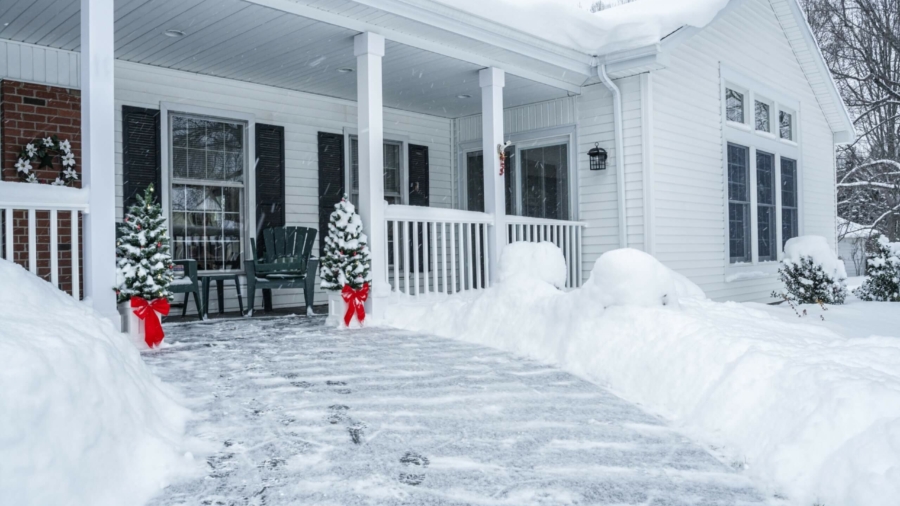Selling your home with the holidays on deck means you may need a crash course in how to decorate your home for the holidays without turning off buyers.
Unless you’re a total Scrooge, it’s hard to argue with the fact that glitter lights and colorful accents make a home look more cheerful and inviting. But you also probably know that if you’re trying to sell your home, buyers need to have an easy time imagining themselves (and their own holiday traditions) in your home.
You don’t have to ditch the holiday decorations altogether. But you shouldn’t hang all the boughs of holly, Christmas lights, Hanukkah menorahs, and every holiday card you receive, either.
So how do you walk the line during these merry months and let the holiday spirit flow without turning off buyers? Hey, we’ve got some tips—an early secret Santa gift from us to you!
1. Depersonalize the decorations
“It’s important the design appeals to as many different home buyers and tastes as possible,” says Erika Dalager, marketing manager at roOomy, a virtual home staging site. “The seller’s personal life should not be prominently featured throughout the home.”
- “Best Mom” tree ornaments your kids made in preschool
- Named Christmas stockings
- Religious tokens and symbols
- A ton of holiday cards
- Photos of your baby’s first Christmas
Hope Mazzola, a real estate broker with William Raveis in Katonah, NY, says glitzing a home with over-the-top decorations is like wrapping a house in an “ugly holiday sweater.”
“Less is definitely more when it comes to holiday decorations while selling your home,” Mazzola says. “Enhancing the features of the home versus adding all the bells and whistles will keep buyers on track.”
2. Consider the neighborhood
But if your neighborhood is ablaze with holidays lights, which herald the block’s values and attract like-minded buyers, then you don’t want to be your block’s resident Grinch, says Tori Toth, a New York City home stager.
“If your neighborhood is festive during Christmas, then a buyer would expect Christmas decorations at your home,” Toth says. “On the other hand, if you live in a politically correct neighborhood with a mix of religious beliefs, use more generic decorations to promote season’s greetings rather than your specific holiday.”
Some real estate pros, however, say you should forgo the decorations regardless of what your neighbors are doing.
“Putting up decorations while your home is on the market poses more risk than it offers reward,” says Sam Pawlitzki, a Los Angeles Realtor. “I recommend that sellers stick to the rule of keeping their house impersonal.”
3. If you must add some holiday flair, here’s how to decorate your home …
Here’s how to decorate your home while it’s for sale during the holidays:
Avoid the kitsch: Inflatable snowmen, reindeer on the roof, a gazillion angels flapping their wings, or life-size Mike Pence mannequins can seem in poor taste and turn off potential buyers.
Classic is always best: Hang an elegant wreath on the front door, rather than a “Santa stops here!” sign, says Jamie Novak, author of “Keep This, Toss That.”
Don’t overdo lights: Simple white lights can add a festive touch without blinding buyers during walk-throughs.
Skip the tree: You can’t win with a tree. If it’s too big, it distracts viewers and can make the room seem small. It can also block the flow and make the space seem crowded. And if it’s tiny, it’s depressing and sad. Decorate a tree only if you have a great room and you want to show off a high ceiling.
Box up the greeting cards: Holiday cards on tables make the room look messy. Stick them in a drawer.
Protect presents: Don’t stack gifts under a tree or put them on display. The last thing you want this holiday is for a stranger with sticky fingers to walk away with a present. Lock the presents in your car trunk, especially during an open house.
Choose scents over scenes: The smell of simmering cider or baked cookies will delight the senses more than garlands strung over everything that doesn’t move.
Light a fire: A roaring fireplace during a weekday showing is a cozy way to celebrate the winter and warm visitors as well.
Pump up powder rooms: Place peppermint-scented soaps and candles in the bathrooms along with a few tasteful, holiday-themed towels. They give the rooms some spirit and interest.
Celebrate your tradition with color: This may not be the year you display the religious symbols of your holidays, but you don’t have to forsake them altogether. If you celebrate Hanukkah, hang a wreath with shades of blue. For Christmas, your wreath can be made of evergreen boughs and pine cones. For Kwanzaa, add red berries to a green wreath.
In the end, the most important holiday decision you’ll make is whether to keep your home on the market during Yuletide: You’ll have fewer house hunters, but more motivated buyers. Ask your Realtor whether you should consider delisting your home for the holiday season, and starting fresh after the new year.
Source: https://www.realtor.com/advice/sell/decorating-selling-your-home-during-the-holidays/








/arc-anglerfish-arc2-prod-dmn.s3.amazonaws.com/public/4CVHC7HLVVD3FMG4SFRKII6BFQ.jpg)




